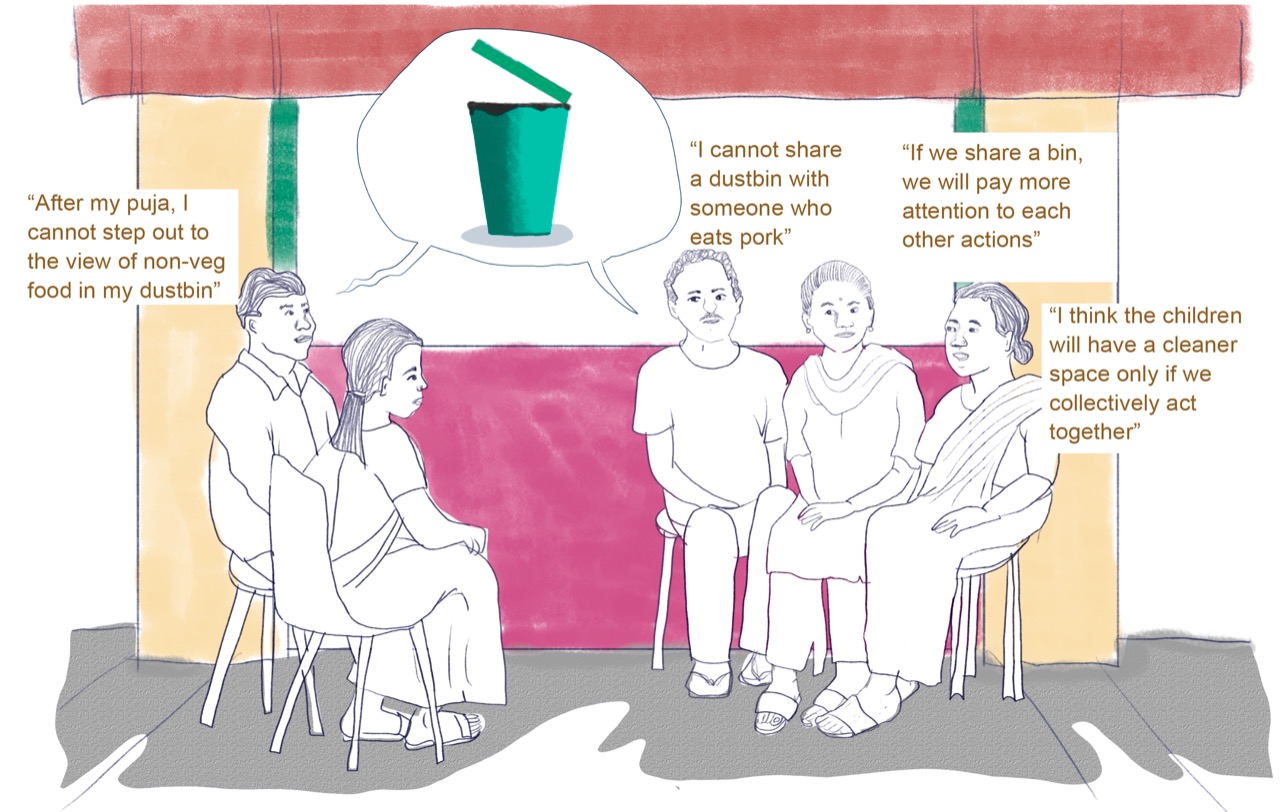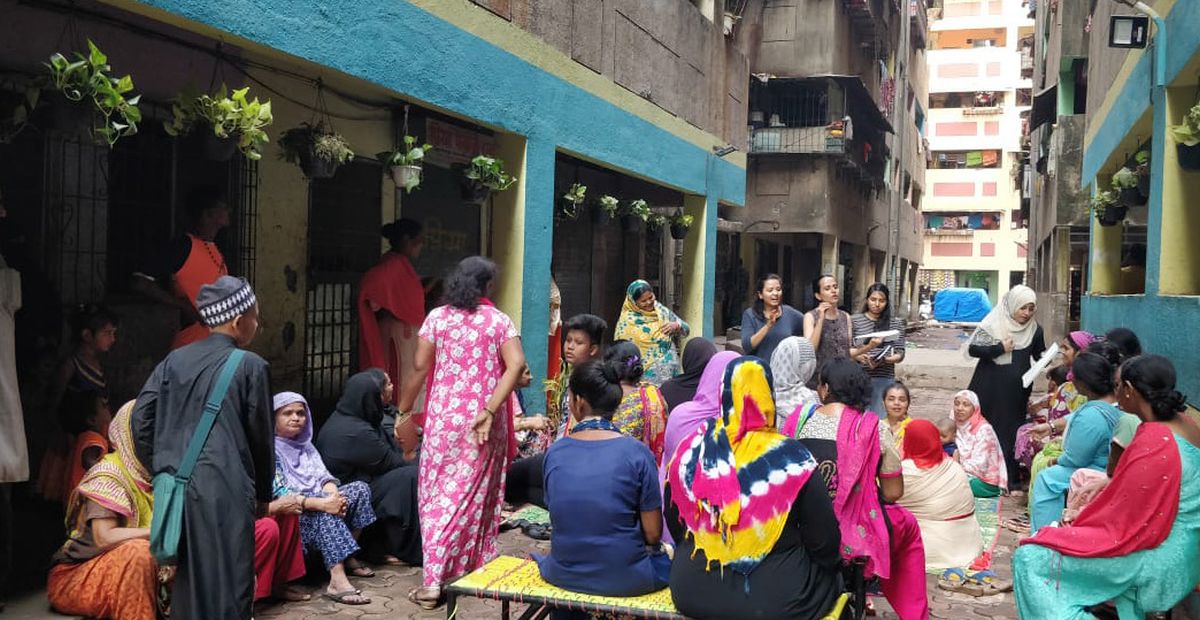This photo essay describes how a participatory design intervention addressing a problem as common as waste management can bring people to collectively drive tangible transformations within their neighbourhood.
“Majha Kachra, Majhi Zabbabdari” a popular cleanliness slogan painted across the walls of Mumbai translates to a simple sentiment – ‘My garbage, my responsibility.’ As convincing as this campaign may sound, it is difficult to find concrete examples of where the slogan is adapted into practice. And the classic blame game continues where people blame the civic authorities for lack of a better system and the authorities blame people for lack of good behaviour. Polices, programs and campaigns become outdated even before they are launched because these initiatives are conceived as band-aid measures without taking the cultural, social and spatial context into consideration.
The eastern suburbs of Mumbai, starting from Kurla and extending into Govandi and Ghatkopar, are some of most densely populated regions in the country or perhaps the world too. This tiny portion is synonymous with slum, both horizontal and vertical, where every inch of earth and sky seems to be occupied. It is no surprise that this region is also notorious for having streets and alleys littered with garbage. Despite multiple cleanliness drives and campaigns, the sight of garbage is omnipresent.
We, at Curry Stone Design Collaborative, have been working with the residents of Natwar Parekh Colony, a resettlement neighbourhood in East Mumbai on various aspects of their built environment. Developed under the SRA (Slum Rehabilitation Authority) scheme in 2005, Natwar Parekh Colony is home to over 5000 families relocated or displaced from different slums or pavement dwellings across Mumbai. Most of the inhabitants are from economically weaker strata of society and are employed as daily wagers or service providers like street vendors, domestic helpers, security guards, rickshaw drivers, construction workers etc.
A number of issues around their built environment, including garbage, are a result of poor planning and design of the colony where the sole purpose of the building was to house as many people as possible, compromising people’s right to adequate light and ventilation. At a policy level, this redevelopment might check all the boxes for adequate permanent housing by providing basic physical infrastructure (such as access to water, sanitation, sewerage, roads, electricity and more) but the way people are cramped into these vertical slums makes some of them wish for a life back on the slums or pavements where they came from.
Our frequent engagement and on-ground observations with them gave us a deeper understanding of how the problem of waste mismanagement was actually a symptom of a larger problem emerging from a deep-rooted lack of ownership within the colony – the people were simply transported from their older units overnight and given homes through a lottery system. They had absolutely no say in what their homes were going to be like or who their neighbours were.
This lack of ownership and participation has extended to their relationship with open spaces. For residents to start taking care of their common areas similar to how they care for their private spaces, it was imperative that these spaces add value to their lives. And therefore, it was important to first generate a sense of ownership and responsibility towards that space.
The intervention around waste was a small step towards reinstating the bond the residents had towards their open spaces when they were living in slums or pavements. In a microcosm, the efforts by the residents of NPC demonstrated a larger relationship between city infrastructure and public behaviors. While the waste management program in NPC is still a work in progress, has helped the residents of the colony extend their imagination towards a better environment, inculcate the value of collective participation, and foster a sense of belonging with the space that they never had.
As sociologist Eric Klinenberg rightly suggests in his book Palaces for the People,“ infrastructure is not a term conventionally used to describe the underpinnings of social life. But this is a consequential oversight, because the built environment — and not just cultural preferences or the existence of voluntary organizations — influences the breadth and depth of our associations. If states and societies do not recognize social infrastructure and how it works, they will fail to see a powerful way to promote civic engagement and social interaction, both within communities and across horizontal lines.”
Natwar Parekh Compound is a public housing neighborhood in the east of Mumbai inhabiting people from slums across the city. With tightly packed grid of 61 buildings on a 5 hectare plot, the density of Natwar Parekh Colony is around 4500 people/ha (Density of the most populated city in the world, Dhaka, is 550 people/ha). Open spaces make up less than 18% of the site area, none of which are usable for any recreational or community activities, keeping residents limited to their 225 square feet apartments.
The rudimentary construction and infrastructure, provides little to no sunlight or proper air ventilation for the residents of the colony. Furthermore, the 4.5 meter narrow alleyways between the buildings are often littered with garbage, hauled over by the residents from their balconies.
The garbage mixed with sewage leaking from broken drainage lines, not only renders these ‘open spaces’ unusable but also makes them an active breeding ground for pests and insects spreading diseases like malaria, dengue, and typhoid and the most prevalent, Tuberculosis. Public health officials and researchers attribute to the dense and cramped planning and design of the colony as the root cause of the problem.
According to the Vasti Swatchta Yojana by Solid Waste Management Department of MCGM (Municipal Corporation of Greater Mumbai), resettlements like Natwar Parekh Colony must have one appointed cleaner for every 150 families. However, the reality on ground accounts for only one third of that number for a colony with more than 5000 families.
For the past 4 years, we, at Curry Stone Design Collaborative (CSDC), have been working alongside the residents of Natwar Parekh Colony to collectively identify and address issues of space and infrastructure in the neighbourhood. In order to bring tangible spatial improvements, it became imperative to address the problem of waste first.
Together with the residents, we approached the issue through a participatory process and designed small interventions around it. These interventions were designed to playfully nudge the residents to see value in their common spaces and act together to transform it.
A section view visualization of one side of a building; the green bin is the shareable wet waste dustbin shared by 6 families on one side of that floor. And the blue colour bins are personal bins for the disposal of dry waste. A total of 15 wet waste bins shareable were used in each building.
Before turning the resident’s attention to open spaces below, we decided to install shareable bins on every floor. If the residents are not able to share a common space, maybe they could start by simply sharing a common dustbin.
When we started sharing this idea with the families on every floor, multiple issues that were rooted in religious, social or habitual differences started to surface. After a number of discussions with the residents, a majority of them decided to join the initiative.
A mural making activity was organized to make the placement of the dustbins in their corridors more inviting and approachable. We designed informative and playful stencil art to engage with people from all age groups to participate.
“I think the children will have a cleaner space only if we collectively act together
15 dustbins were installed alongside 15 freshly painted walls which carried information on safe practices around waste management in one building. After the installation, the bins were inaugurated by all residents of each floor.
Over the course of the next six months, 12 more buildings adopted this system, which was tweaked to accommodate each building’s needs. Some buildings installed both wet and dry shareable bins.
A system between residents, waste collectors and a compost unit near the colony was conceived. An average of 3-4 kgs of wet waste per building per day, which was previously thrown outside of their homes, was now being collected and picked up by a composting unit near by.
To understand if this system was working, we observed the lanes between the buildings and found them to be visibly cleaner and accessible
Over the course of a few months, we chose one of the lanes between two buildings and turned it into an active social space.
 With simple design interventions like adding plants, benches, lighting, tiling and painting with participation of the residents – the social space came to be known as ‘mini garden’ of Natwar Parekh Colony.
With simple design interventions like adding plants, benches, lighting, tiling and painting with participation of the residents – the social space came to be known as ‘mini garden’ of Natwar Parekh Colony.
The space became a gathering spot for elderly and children started hosting cricket matches. A wedding was also organised there a few weeks after the space was inaugurated.
Upon seeing the transformation of one lane from a dead and dirty space into a vibrant community space, other residents came forward with requests of turning the alleyways between their buildings into ‘mini gardens’.
Before the pandemic struck and physical distancing norms took over the public life, we had planned to clean and transform every alleyway in the colony and have the community host Iftar in these spaces during the month of Ramzan together.
– Article by Natasha Sharma and Bhawna Jaimini, Research Associates at Curry Stone Design Collaborative.
Image credits to the residents of the colony and the CSDC team Initiative led in participation with the residents of the colony and with the help of Parveen Shaikh, our community organiser and also a resident of Natwar Parekh Colony.
Participatory mural painting led by our young community representatives – Mizbah, Nida, Bushra, Najmun, Rohit and Sahil.
Social space elements built by the residents with their skills and expertise of weaving, carpentry, painting and electricals.
Curry Stone Design Collaborative is a Mumbai-based architecture and design studio. We work alongside diverse communities in identifying and addressing their collective needs for an improved built environment through participatory planning, community-driven design and architecture, advocacy and consultation.




























